The Tata Tiago EV, India’s most approachable electric vehicle, has arrived and is built on a traditional basis from the Tiago’s combustion-engine predecessor. Here is our first drive report.

Story: Kurt Morris
Photography: Sanjay Raikar
Tata Motors have a strong presence in the Indian market they have been making efforts to expand their offerings in the electric vehicle (EV) segment. Tata Motors have launched a number of EVs, including the Tigor EV and the Nexon EV. The Tigor EV is the compact sedan that was launched in 2017 and set the ball rolling for the company in terms of getting into the EV market. It had a range of up to 142 kilometres on a single charge. The Nexon EV, launched in 2020, has a range of up to 312 km on a single charge. It also has a fast-charging option that allows it to get charged up to 80 per cent in just one hour. The Nexon EV is currently the best-selling EV in India. Building on all this learning, Tata Motors have launched the Tiago EV which they hope will democratise EV ownership.
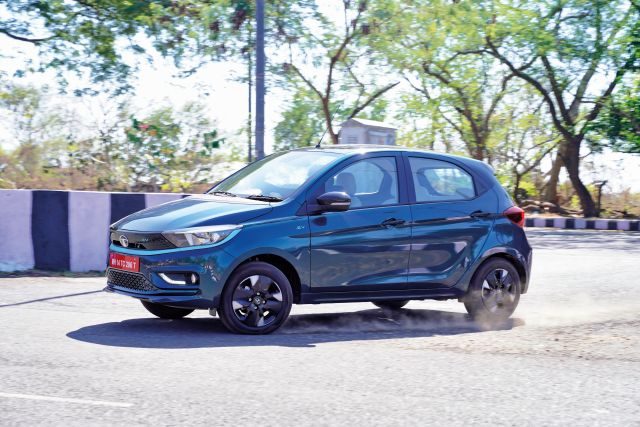
With the Tiago EV, the company hopes to attract more automobile customers to the electric brigade than any other EV has been able to. This EV has received 20,000 reservations since its launch in India at a starting price of Rs 8.49 lakh (ex-showroom), demonstrating that the general public is ready for reasonably priced electric mobility.
Contrary to the negative connotations of affordability that are sometimes associated with EVs, the Tiago EV is a well-rounded product, especially given the price at which the technology is delivered. Similar to the 2016-released ICE-powered Tiago, the car’s bodywork features exactly the same shape. Tata succeeded in giving the electric version a welcome facelift despite the six-year-old design. The car’s front grille is adorned with the unmistakable tri-arrow ornamentation, while the top grille is painted in the signature blue hues Tata have used to decorate all their electric vehicles.
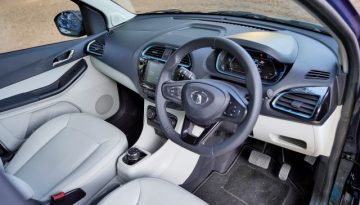
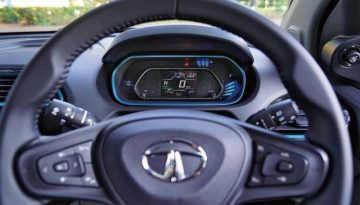
The front grille has been replaced with a black plastic panel shaped after an EV and bearing the “ev” badge, a feature that is also visible on the fenders. The 14-inch wheels, which are expertly disguised steel wheels with wheel-coverings that look like alloy wheels, are the only substantial modification. The rear hatch now bears a distinctive “Tiago EV” badge on the back to make it stand out from other vehicles.
The only obvious difference between the Tata Tiago EV’s cabin and that of its ICE counterpart is the absence of the gear lever in favour of the rotary drive selector knob in the electric form. With inserts on the dash and centre console, the interior also features blue highlights. The all-white leatherette upholstery is a charming touch that enhances the cabin’s feeling of openness.
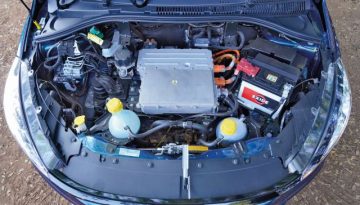

One can switch among the regen modes. One gets to choose from three modes of regen using a switch located on the centre console. The EV comes with a seven-inch touchscreen infotainment system with Apple CarPlay and Android Auto compatibility, the same as in the basic Tiago. In addition, there is automatic climate control, cruise control, height-adjustable driver’s seat, and steering-mounted audio controls, to mention a few. The top trim of the EV also comes with an eight-speaker audio system. Being an EV, one can really enjoy this Harman sound system.
Apart from that, the Tiago EV’s cabin is still comfortable, roomy, and useful. The seats in the front offer adequate support. Personally, I didn’t experience any shoulder-rubbing with another passenger. As I moved to the second row, I was pleasantly surprised to see that despite the batteries below, the floor height was mostly unchanged from the Tiago standard. It feels luxurious thanks to the leatherette upholstery at the back, but the absence of an adjustable head-rest is unfortunate. Last but not least, we have the boot space, which, at 240 litres, isn’t significantly smaller than the ICE-powered Tiago’s, which is 242 litres.

Due to its foundation in Tiago’s four-star NCAP rating architecture, it also scores highly for safety. We also tried the ZConnect mobile app which provides every piece of cutting-edge linked auto technology. It offers remote access to the vehicle’s controls and a brand-new driving behaviour report, which will undoubtedly aid new EV buyers in adjusting to EV driving habits.
The motor is tuned to produce 55 kW (75 hp) on demand and 114 Nm of maximum torque in the range-topping version that we tested. With this level of tuning, the Tiago EV can accelerate from 0 to 60 km/h in 5.7 seconds, which is fast for a compact hatch, especially given that the vehicle’s kerb weight has increased by 150 kilograms. We drove the car for 150 km in Goa during our test, alternating between highway and city traffic.
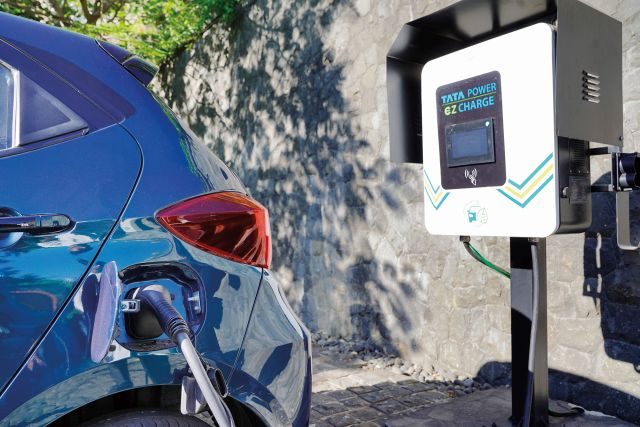
Except for the Sport mode, the transmission is linear and leisurely. The acceleration is swift when you shift to S on the dial. The Tiago EV wants to move rapidly wherever you put it in S mode, which unquestionably modifies its character. It accelerates gradually in this situation, making it perfect for city driving and keeping up with traffic, whether on a highway or at city speeds.
The 15-amp charging point will take about nine hours to fully charge the long-range version, whilst the 3.3-kW charger would do the job in 6.4 hours. The 7.2-kW charger, which takes 3.5 hours, is the sensible choice. If you do find a DC fast-charger, it will charge from 10 per cent to 80 per cent in just 57 minutes. The long-range model we have here has a stated range of 315 km once fully charged.
Overall, Tata Motors are making significant efforts to expand their presence in the electric vehicle market in India and are working on developing a range of electric vehicles that cater to the needs of different segments of the market.

Considering the value proposition of an electric car and the savings that go along with it, the range-topping version of the Tiago EV costs Rs 11.79 lakh (ex-showroom), which is roughly Rs 3 lakh more than the conventional version. According to our perspective, the Tata Tiago EV could be the vehicle that popularises electric vehicles.




